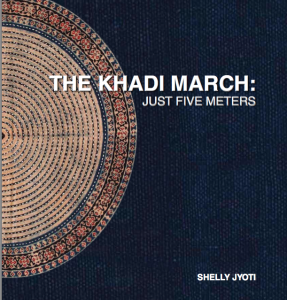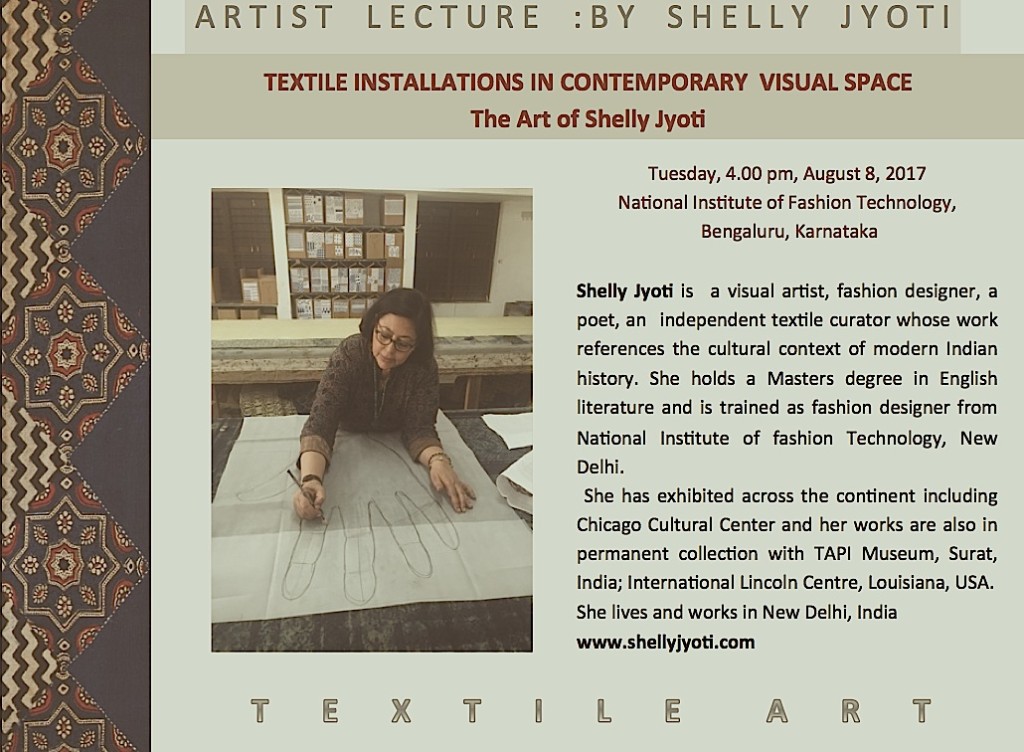
AN ART TALK: NATIONAL INSTITUTE OF FASHION TECHNOLOGY , BENGALURU, AUGUST 8, 2017
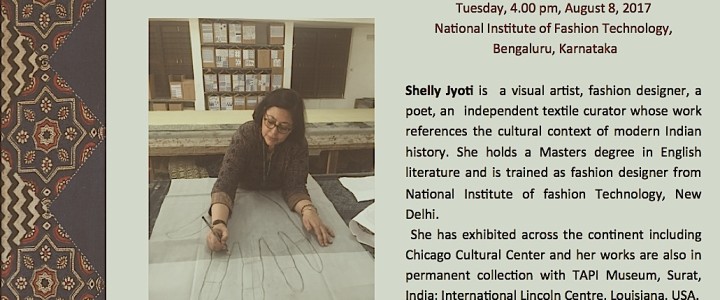




SAVE THE DATE THE KHADI MARCH: JUST FIVE METERS BY SHELLY JYOTI
THE KHADI MARCH: JUST FIVE METERS BY SHELLY JYOTI
October 2-30, 2017
NATIONAL GALLERY FOR MODERN ART, BENGALURU
In conjunction with
Indira Gandhi national Centre for Arts, SRC
Link: Read more

REUNION ||
WOMAN MADE GALLERY
685 Milwaukee Ave, Chicago, Il 60642
Opening Reception : July 7, 2017 |6-8 pm
Link: Read more
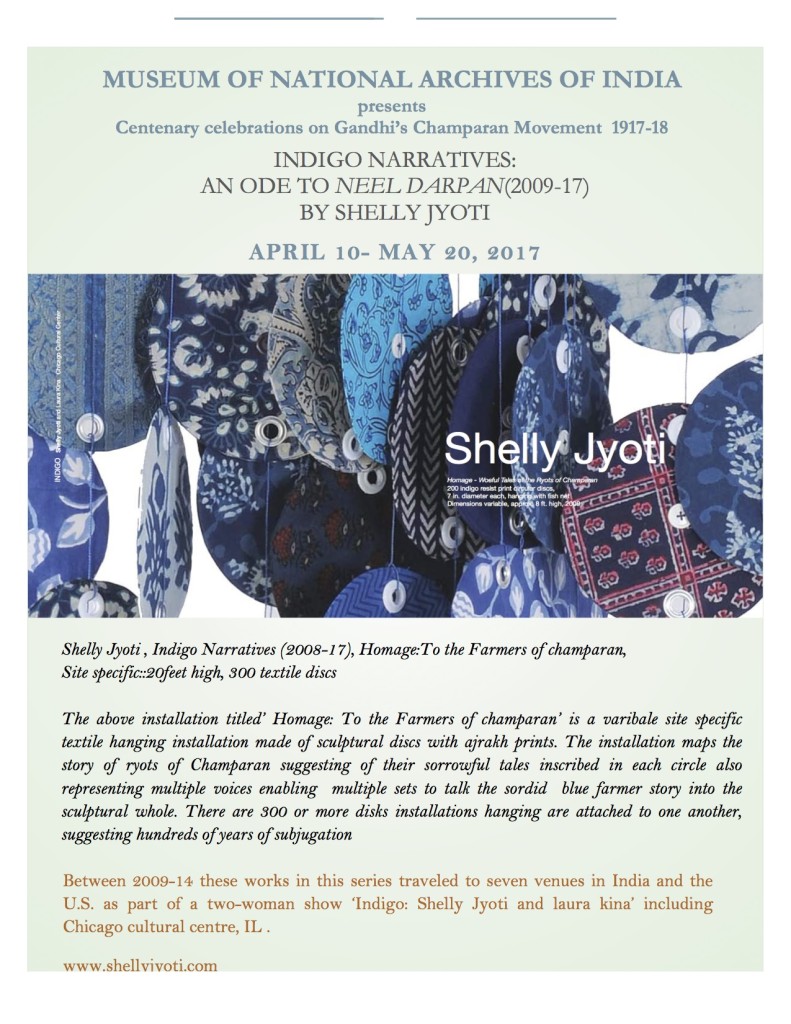
INDIGO NARRATIVES: AN ODE TO NEEL DARPAN 2009-17
MAY-JUNE 2017
THE MUSEUM FOR NATIONAL ARCHIVES OF INDIA,
JANPATH , NEW DELHI , INDIA
Link: Read more
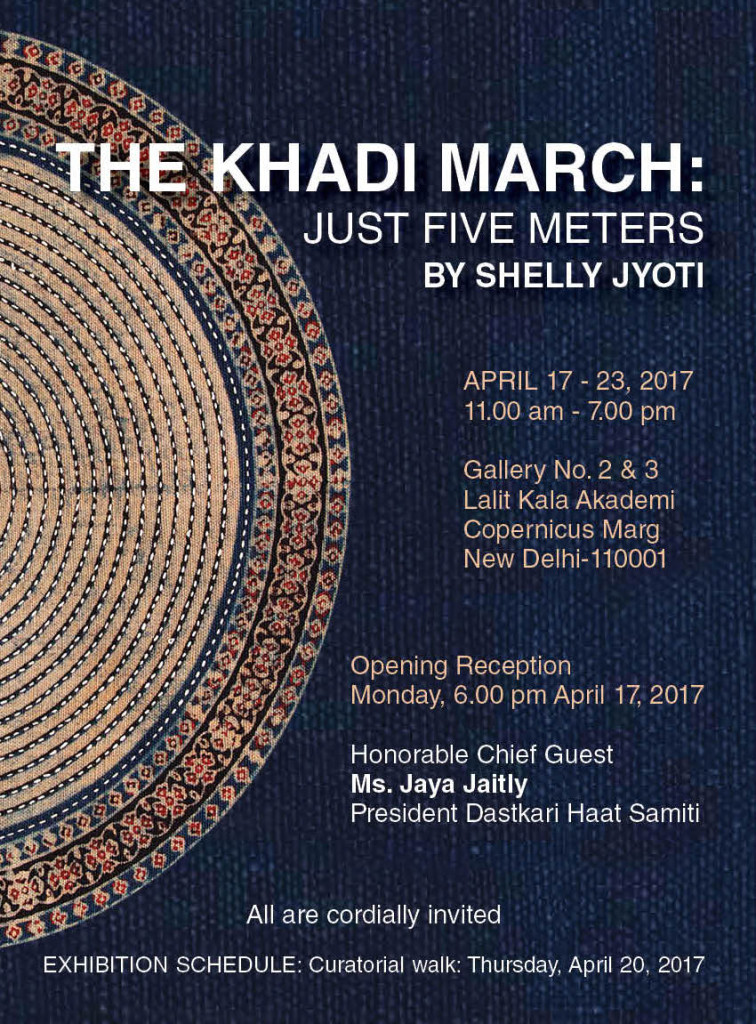
THE KHADI MARCH: JUST FIVE METERS BY SHELLY JYOTI
APRIL 2017
LALIT KALA AKADEMI , NEW DELHI , INDIA
Link: Read more
ABOUT: Shelly Jyoti
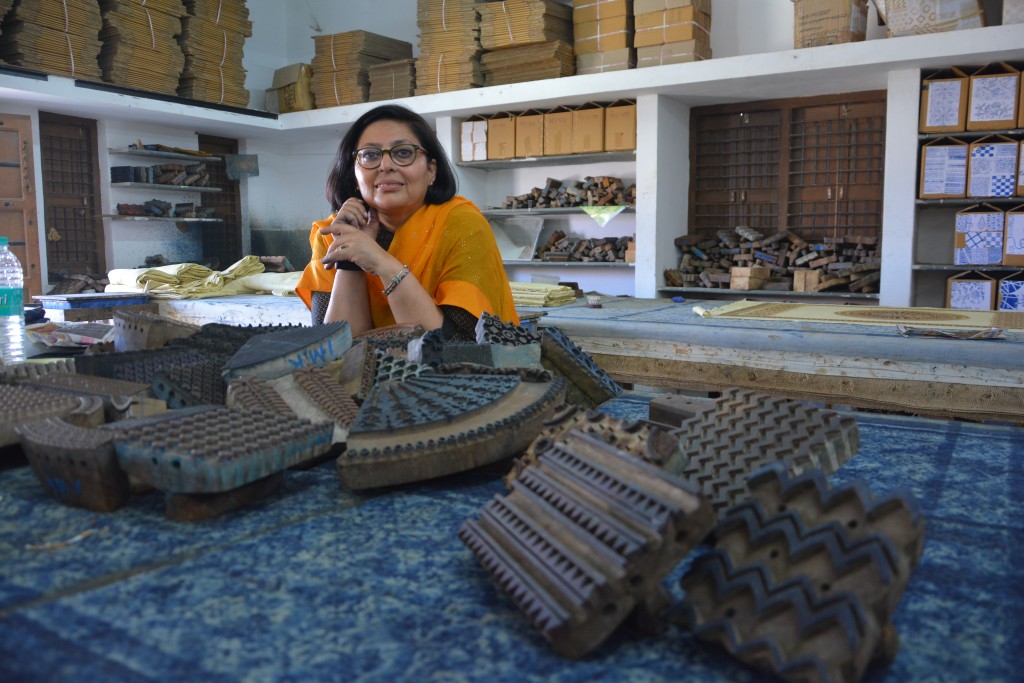
A textile artist, fashion designer, a poet and an independent curator
Working with various media and excavating from history, shelly Jyoti’s art celebrates the subaltern, the folk, and the voices of the unsung heroes and voices, which need to be sung again. Her work as an artist is centered on historical iconographic elements within the cultural context of Indian history exploring and constructing the hermeneutics of period histories, its contemporary representation of socio-political inquiry within her art practice.
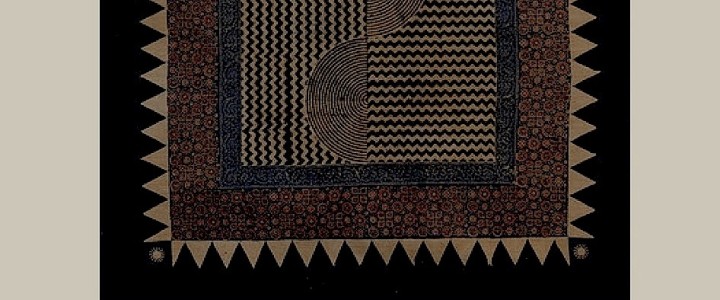
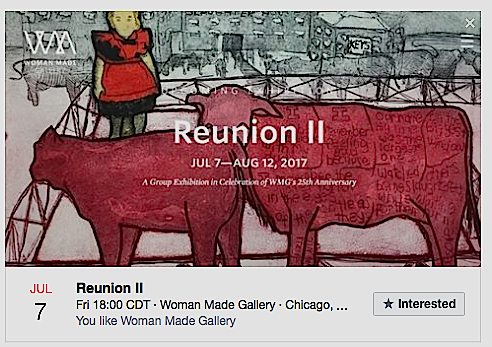
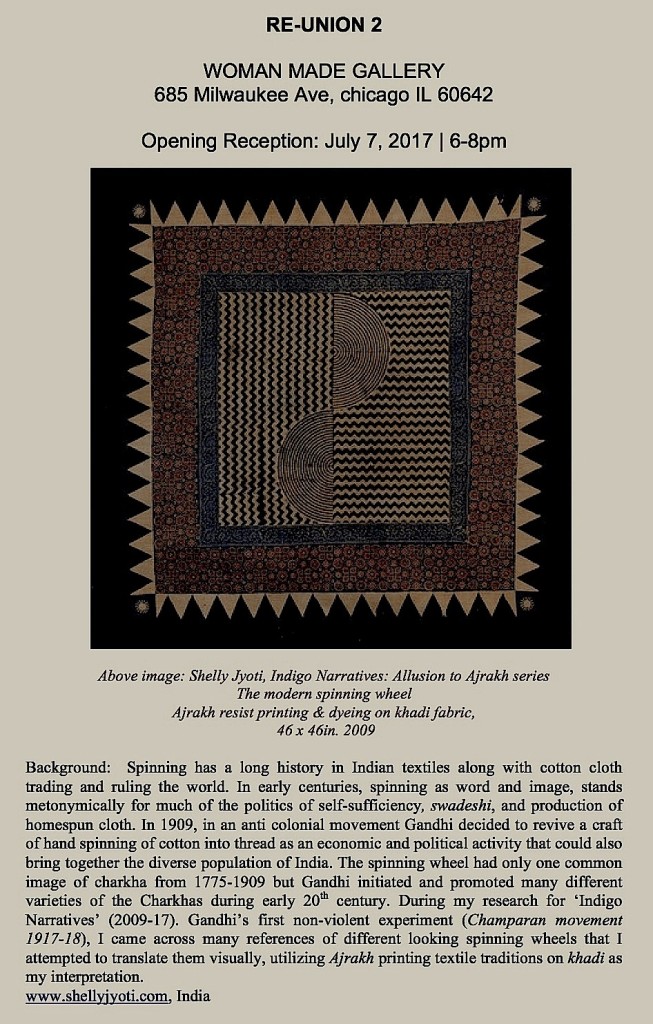
MAPING AJRAKH TEXTILE TRADITIONS IN CONTEMPORARY ART AND CRAFT: THE ART OF SHELLY JYOTI
This short documentary film by Shelly Jyoti features the processes of Ajrakh textile traditions and craftsmen collaboration with contemporary visual artists. It explores newer dimensions, the critical relationship between the materials and traditional processes used in Ajrakh production and to develop a deeper understanding of the critical role that cloth, fiber, natural dyes, and environment each play maping Ajrakh traditions in contemporary art and craft.
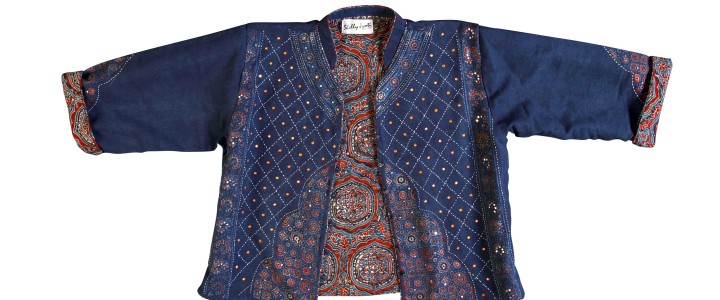
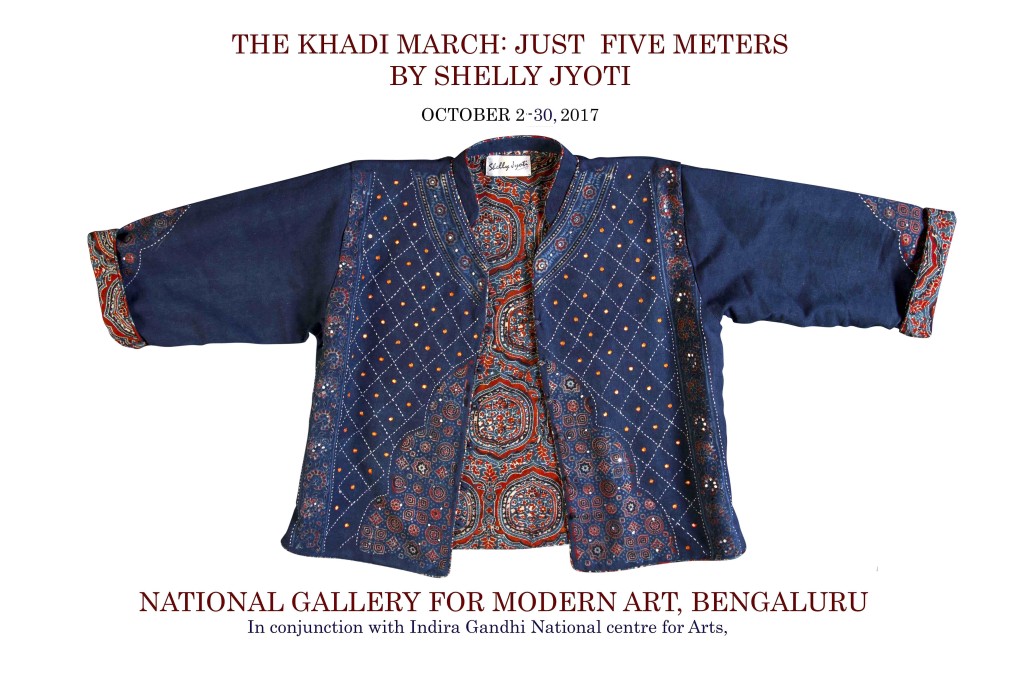

INDIGO NARRATIVES : AN ODE TO NEEL DARPAN (2009-17)
by Shelly Jyoti

INSTALLATION1
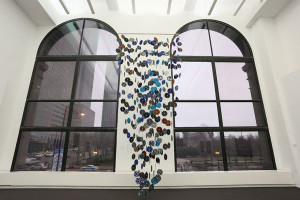
Shelly Jyoti
Indigo Narratives (2008-17)
Homage:To the Farmers of champaran
Image: Chicago Cultural Centre, IL,USA, 2013
The above installation titled’ Homage: To the Farmers of champaran’ is a varibale site specific textile hanging installation made of sculptural discs with Ajrakh prints. The installation maps the story of ryots of Champaran suggesting of their sorrowful tales inscribed in each circle also representing multiple voices enabling multiple sets to talk the sordid blue farmer story into the sculptural whole. There are 300 or more indigo dyed disks installations hanging are attached to one another, suggesting hundreds of years of subjugation. The parallels of circles hanging with different placement of traditional and contemporary prints also explores the manipulation of visual effect and aesthetics.
INSTALLATION 2

Shelly Jyoti
Indigo Narratives (2008-17)
Homage: Ballad of blue farmers of Champaran
2009
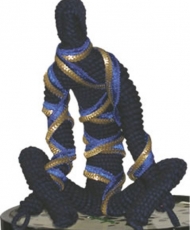 The above installation Homage: Ballad of blue farmers of Champaran 1917-18 is about 8ft high site specific -displays 16 human structures of 15” height, corded in twisted indigo cotton rope with metallic chains perched on black acrylic painted wooden buttons convey how the native farmers were oppressed for Eurocentric need by colonizers in eastern India. The indigo plantation became deltaic obsession with Britishers after World War 1. The sculptures hanging from top to bottom at different levels suggest their persistent demands to free them from land revenue system as that was leading the native farmers/ families in debts and eventually deaths. The metallic chains around the farmer is suggestive of slavery and oppression and exploitation.
The above installation Homage: Ballad of blue farmers of Champaran 1917-18 is about 8ft high site specific -displays 16 human structures of 15” height, corded in twisted indigo cotton rope with metallic chains perched on black acrylic painted wooden buttons convey how the native farmers were oppressed for Eurocentric need by colonizers in eastern India. The indigo plantation became deltaic obsession with Britishers after World War 1. The sculptures hanging from top to bottom at different levels suggest their persistent demands to free them from land revenue system as that was leading the native farmers/ families in debts and eventually deaths. The metallic chains around the farmer is suggestive of slavery and oppression and exploitation.
INSTALLTION 3
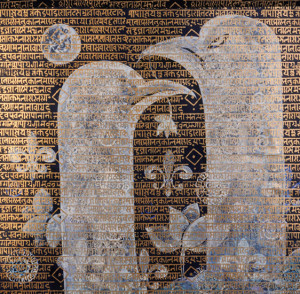
Indigo Narrative : An Ode to Neel Darpan
Acrylics on canvas, triptych
30×23 inches each, 2009
Each panel of the triptych exhibits the images of hawks that are metaphorical to the British who twisted the indigo farmers with their razor sharped beaks with lotuses in their beaks rising over a ground with worms. The hawks, representing the British colonizers, twist and manipulate lotuses in their beaks. The lotuses signal planters, British and Indian individuals who acted as intercessors and translators between the British colonizers and the indigo farmers, here represented as the hardworking and severely underappreciated worms
INSTALLTION4
Indigo Narrative : An Ode to Neel Darpan 2009-17
Indigo: The Blue Farmers
Multi media spoken word poetry, 52 lines
2009
INSTALLTION5
Indigo Narrative : An Ode to Neel Darpan
Indigo Narratives: Narration in resist( a section)
2009

Shelly jyoti,
indigo Narratives: Narration in Resist
Ajrakh printing and dyeing and painting on khadi
2009
Installation 6
Shelly jyoti
Indigo Narrative :The paper boat
Newspaper Origami
6×18 inches each, 2009
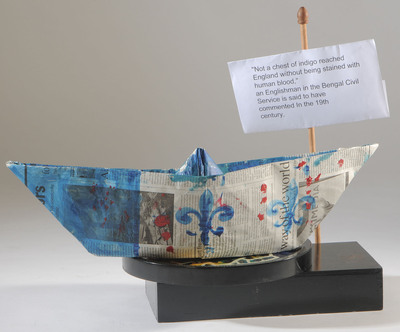
Not a chest of indigo reached England without stains of human blood
This origami boat is representative of media, translation of story of indigo farmers written by Deenbandhu Mitra(1860). The translated copy from vernacular to English by Madhusudan was sent to British parliament and became a media discussion with elite of Calcutta of bringing awareness of the plight of farmers.
Installation 7

Shelly jyoti
Indigo Narrative : The neel coolie jacket
Acrylics on canvas
30×23 inches each, 2009
The installation sculpture Indigo narratives: Neel coolie jacket is fully structured and fully finished ready to wear, size medium , painted canvas with army print lapels investigating the Eurocentric need of indigo color during the World War I with a brass identification of the porter/coolie on the arm.
The jacket is constructed signifying the oppression and forced labor symbolically and further investigate the presence of indigo as dye/ color that brings together natural history, science, technology, global economics, politics, spirituality and art in the past with the present.
Indigo Narratives: An ode to Neel Darpan (2009-17)
Over view:
Indigo holds a sustained presence in the post-colonial identity of India.
These works draws upon India’s history, literary accounts of oppression on farmers of Chamapran movement in 1917-1918. These narratives are inspired by the social, economic and political, historical references and situations affected by the tyranny of British colonial indigo planters on native farmers and Mahatma Gandhi’s subsequent intervention in Bihar, the first satyagarh led by Mahatma Gandhi on the Indian soil after his South African experience of fight against racialism. In the 19th century, Bengal was the world’s biggest producer of indigo but today, the deep blue color of indigo is synthetically created in a lab and is associated, in the West, with blue jeans more than its torrid colonial past.
Neel Darpan’(1860) was written by Dinbandhu Mitra on the plight of indigo farmers. The play portrayed the eco-political exploitation by the colonizers in early 19th century. ”An Ode to Neel Darpan ‘is a narrative retold in site-specific installations. The installations re-contextualize with tapestry of designs and are a tribute to indigo farmers of Champaran. The block printed disks are inscribed with 15 different traditional and contemporary indigo print which maps the story of ryots of Champaran suggesting of their sorrowful tales inscribed in each circle
Artist statement:
The works engage textile reference of ajar printing and dyeing of coastal Gujarat, literary texts such as Neel Darpan through the history of India’s colonial past along with references to indigo plant/color/dye. The use of azrak printing on khadi in my works is examining the immigrants with indigo technique which came along with them. I examine the implication of personal, political and cross cultural choices of communities that migrated from Sindh and Baluchistan with the craft of indigo, with a strong narrative element to create and yet preserve their identities. I create a cultural context of my work by narration of ‘Neel darpan’ through visual medium. I went and worked with 9th generation Azrak artisans in Bhuj in interiors of Gujarat on khadi fabric with ancient indigo resist printing technique with contemporary prints and ideas of 2009. My works interpret the politics of indigo with objects, sculptures installations and paintings within my Indigo narrative 2009-2017 series.

Shelly Jyoti , Salt: The Great March 2013-14
Omnipresent 2
Ajrakh printing dyeing and needle work on khadi
2013
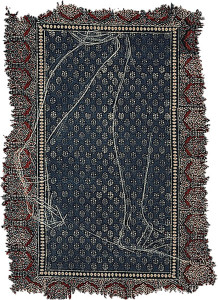
Shelly Jyoti , Salt: The Great March 2013-14
Omnipresent,
Ajrakh printing dyeing and needle work on khadi
2013
EXHIBITION & LECTURE SCHEDULES: 2009-17
Between 2009-14 these works in this series traveled to seven venues in India and the U.S. as part of a two-woman show ‘Indigo: Shelly Jyoti and laura kina’ including Chicago cultural centre, IL. It has recently re- opened in India at the Museum of National Archives of India.
April-may 2017: The Museum of National Archives of India
2013 November-Gandhi Memorial Centre ,Washington DC, USA
2013 January -until April 27 2013 – Chicago Cultural Center – IL USA
2011 May Diana Lowenstein Gallery Maimi USA
2011 January Art exchange Gallery Seattle USA
12 -18 January, 2010 Nehru Center Worli, Mumbai, India.
23-28 December, 2009 Open Palm Court Gallery, India Habitat Centre New Delhi India
15-16 December, 2009 Red Earth Art Gallery, Baroda, Gujarat India.
LECTURE & TALKS Indigo:Shelly Jyoti & Laura kina 2009-14
2013
January 30, 2013 Artist Talk Quilting , Art history and Metaphor DePaul University students With Prof Jean Bryan Chicago Rooms, Chicago Cultural Center,IL,USA
January 31,2013 Public Lecture Artist talk Indigo:Shelly Jyoti & Laura kina Shelly Jyoti, Laura kina and Pushpika Frietas ,Chicago Rooms, Chicago Cultural Center,IL,USA
February 11,2013 Artist Talk- Indigo:Shelly Jyoti & Laura kina Art Institute of Chicago, students with Prof Nora Taylor- Asian Art Now , Chicago Cultural Center,IL, USA
February 20,2013 Artist Talk: Art Institute of Chicago,Textile Society, Chicago Cultural Center,IL, USA
2011Lecture &Talk Collaborations :Indian and US Artist WomanMade Gallery,IL,USA
2009 Lecture & Talk 31st December -Forum for Contemporary Theory Baroda, Gujarat, India
Lecture The Politics of Indigo : Revisting India’s Torrid Colonial past
IMPORTANT LINKS:
https://www.shellyjyoti.com/video-indigo-narratives/
https://www.shellyjyoti.com/indigo-narratives/multimedia-spoken-poetry-indigo-narratives/

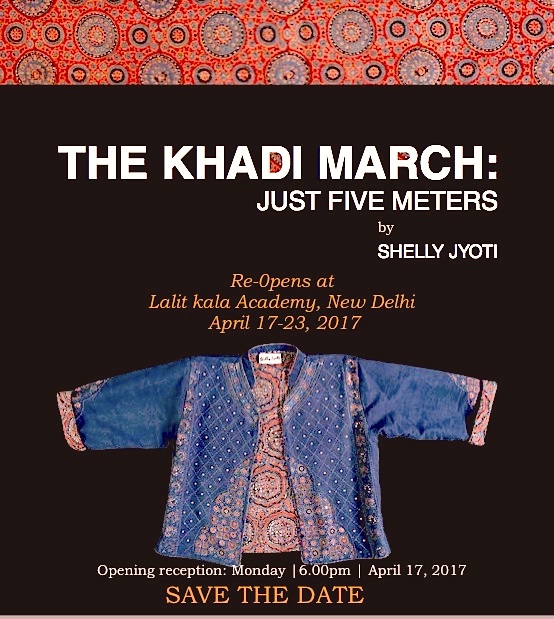

‘Installation art : Objects, Things and Symbolism’
Presenting a paper for 19th FCT International conference at Dehradoon University
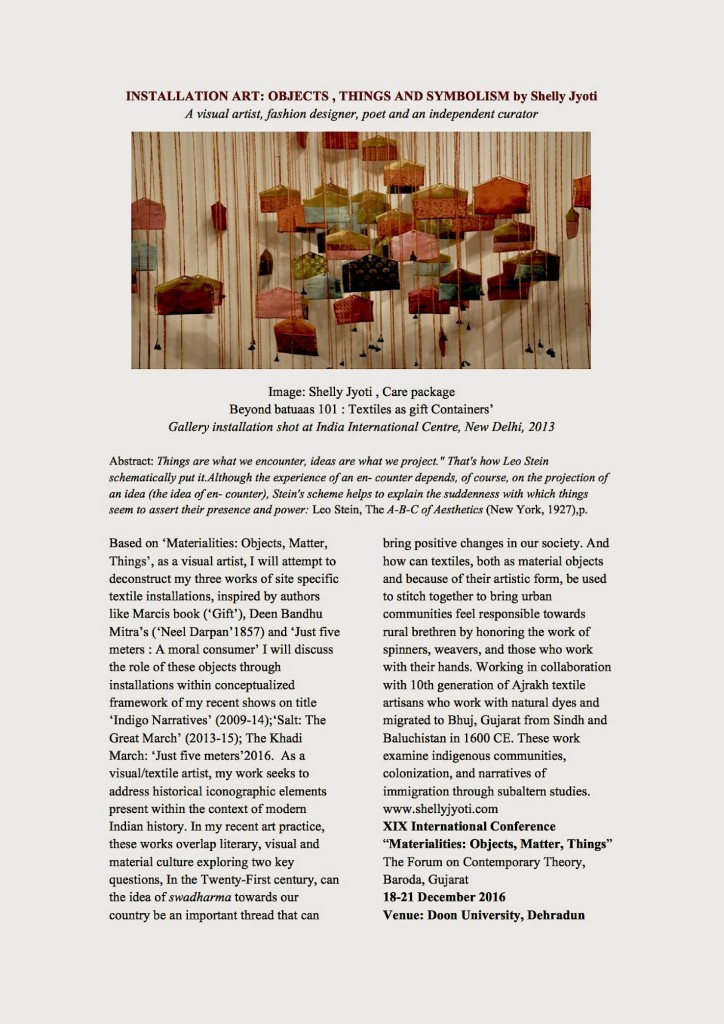

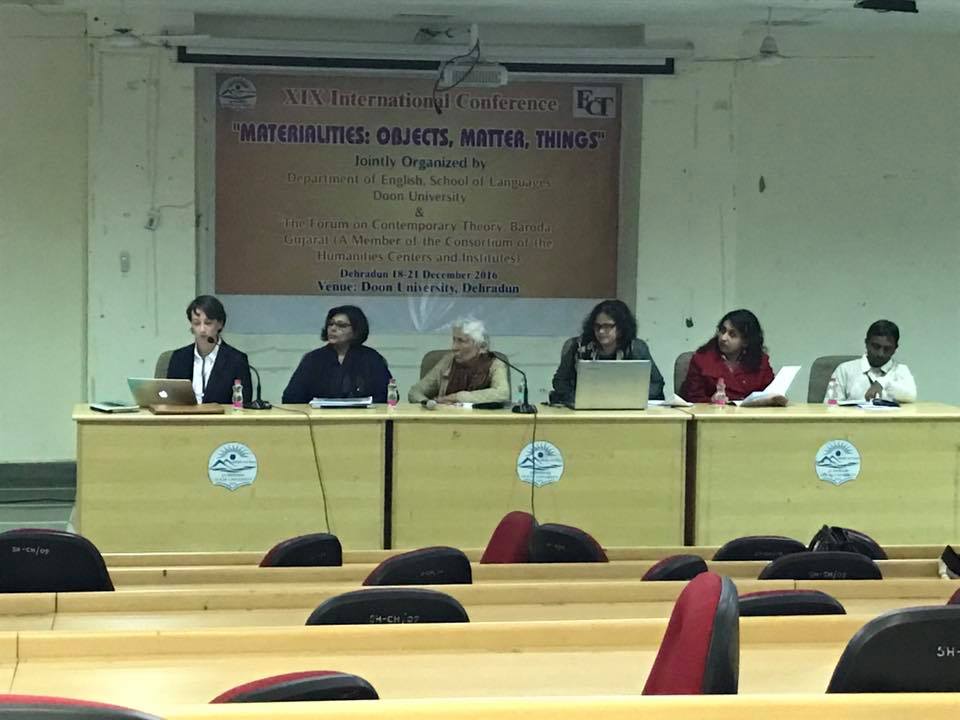
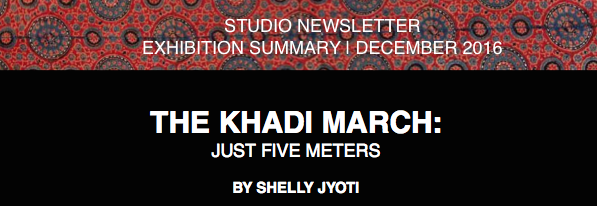


OVERVIEW:The Khadi March: Just five meters is a call to action that challenges people who live in urban cities to grant dignity to the rural brethren and to rethink our engagement with the spinners, weavers and people who work with handicrafts in the villages
Click here to read more
Upcoming: October, 2017
National Gallery for Modern Art, Bengaluru, India
17-23 April, 2017 lalit kala Academi, New Delhi, India
20-26 Oct, 2016 Visual Arts Gallery, India Habitat Centre, New Delhi, India
ARTIST STAT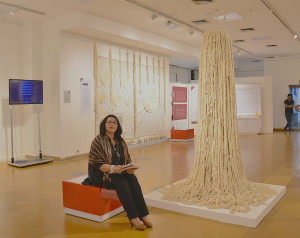 EMENT: As a visual and textile artist, my work seeks to address iconographic elements present within the context of modern Indian history and contemporary society. ‘The Khadi March: Just five meters’(2016) continues to explore Gandhi’s idea of swadharma, a subject I have pursued in two previous projects, ‘Indigo Narratives’ (2009-14) and ‘Salt: The Great March’ (2013-15).
EMENT: As a visual and textile artist, my work seeks to address iconographic elements present within the context of modern Indian history and contemporary society. ‘The Khadi March: Just five meters’(2016) continues to explore Gandhi’s idea of swadharma, a subject I have pursued in two previous projects, ‘Indigo Narratives’ (2009-14) and ‘Salt: The Great March’ (2013-15).
Click here to read more
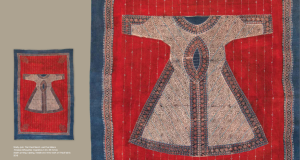
ARTWORKS:These artscrolls are created in collaboration with Ajrakh artisans to document the blocks and laborious printing /dyeing technique.The purpose of creating these artwork Timeless silhouette of different contemporary silhouettes that have the western and orient influences. I am also trying to document the upper body wear that has been worn by women of India in the 21st century Click to view
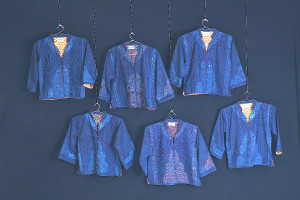 ART INSTALLATIONS:
ART INSTALLATIONS:
I am exploring the idea of khadi as a visual expression of national identity for the 21st century by connecting urban consumers and rural producers. The title of the piece was inspired by Lisa Trivedi’s Clothing Gandhi’s Nation: Homespun and Modern India.
Click to view more
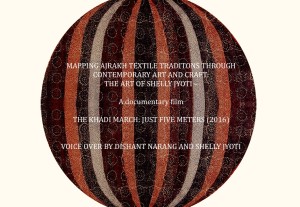
A SHORT DOCUMENTARY FILM :
Mapping Ajrakh Textile traditions in contemporary art and craft: The Art of Shelly Jyoti 2016
This short documentary film by Shelly Jyoti features the processes of Ajrakh textile traditions and craftsmen collaboration with contemporary visual artists. It explores newer dimensions, the critical relationship between the materials and traditional processes used in Ajrakh production and to develop a deeper understanding of the critical role that cloth, fiber, natural dyes, and environment each play maping Ajrakh traditions in contemporary art and craft.
Click to view the Youtube link
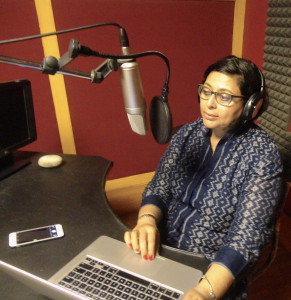 MULTIMEDIA SPOKEN WORD POETRY
MULTIMEDIA SPOKEN WORD POETRY
Shelly Jyoti, ‘The khadi March: Just five metres’
Video duration: 07.05 minutes; Magic lantern slides . 143 lines
Just five meters: My friends – An urban appeal
2016
The poem was written following my own 2013 visit to Dandi, the final destination of Gandhi’s eventful Salt March of 1930. Meeting and listening to veteran freedom fighters, including Acharya Dhirubhai and Gosaibhai Patel, both inspired and troubled me. click to view the youtube link
 OPENING AND INSTALLATION SHOTS
OPENING AND INSTALLATION SHOTS
Visual Arts Gallery, India Habitat Centre, 20-26 Oct, 2016
Chief Guests and others : Smt Tara gandhi Bhattacharjee(Grand daughter of Mahatma Gandhi); Shri Vinai kumar saxena-Chairman , khadi village industries commission; Meenakshi Lekhi-Member Parliament, Gurujee Narayana, Bim Bissel and family from FAB India, friends, family and many others.
 CATALOG
CATALOG
Fully illustrated coloured pages 76, Dimension:11x 8.5 inches
Foreword by Smt Tara Gandhi Bhattacharjee, Grand daughter of Mahatma Gandhi
Comunicating for Community in Our Times by Lisa Trivedi
Professor of History, Hamilton College, U.S.A, Author of Clothing Gandhi’s Nation: Homespun and Modern India
Swadharma: The Khadi March by Guru Narayan jee
Guru Narayana jee is a management guru. An exponent on Bhagwat Gita, a mentor to many chief executives and is a yogic volunteer, serving rural and urban India.
PDF: The khadi March: Just Five Meters
Publication date: Oct 2016

PANEL DISCUSSION
The Poetics of Khadi: Cutting across time and space
Bikaner House, Shahjahan Road, India Gate, New Delhi
PANELIST: Ritu Beri-Fashion designer; Meenakshi lekhi-MP; Shelly Jyoti- A visual/ textile artist; Geeta Goradia- Chairperson Jewel Industries, Varsha Das- a Gandhian thinker,art critic and littterateur; Poonam Goel- Delhi based art writer and journalist (moderator)
‘ Let’s ignite this urban socialism -you, me and three hundred million of us -for sake of rural brethren – Just buy five meters, simply once a year, simply once year! As a notion of swadharma towards our country
we can together do it!’ Excerpt from poem ‘Just Five Meters :An urban’ Appeal by Shelly Jyoti
Click the video of the event:
Khadi: A Social Equalizer. A Short Video under YES Institute ‘Craft in India’ Series
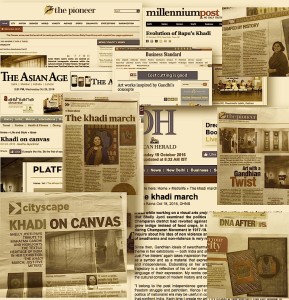
PRESS AND MEDIA COVERAGE
THE KHADI MARCH: JUST FIVE METERS BY SHELLY JYOTI
The Pioneer, Hindustan Times, Asian age , Business standard, Deccan herald, Indian Express, The week, India Today, The Hindu, Metropolitan plus, Platform, Sunday Guardian, Metroplus, DNA after hrs, Metrolife, Mint, Millinium post, Asian age –cityscape, Asian age art+ ,Mojarto.com and many online websites, A TV interview by NDTV profit prime
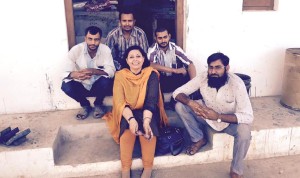 ACKNOWLEDGEMENTS
ACKNOWLEDGEMENTS
MAKING OF ‘THE KHADI MARCH: JUST FIVE METERS’ (2016)Smt Tara Gandhi Bhattacharjee for writing catalog foreword and sharing her poetry ‘Spinning wheel’ for the show; Prof Lisa Trivedi Hamilton, Professor of History, Hamilton College, U.S.A, Author of Clothing Gandhi’s Nation: Homespun and Modern India for the writing the catalog essay and peer review; Dr Alka Pande, Curator & Director of Visual Arts Gallery and her team; Shri Gurujee Narayana, an exponent on Bhagwat Gita and Vedic literature for writing the essay on Swadharma as catalog essay and his blessings; Poonam Goel-Personna; Audio recording Studio: Pindrop, Haus khas, New Delhi; Dishant Narang for lending his voice over for Multi media spoken word poetry and the documentary film; Ajrakh Artisans in Bhuj-Ashraf, Ishak Ali Mohamed, Juber Adam, Razak siddique; Master craftsman -Junaid Ismail M khatri; Photography: Inder Gopal, New Delhi; Khandelwal Interiors: Constructional finishes, New Delhi; Dress forms: Figurette INC kalkaji, New Delhi; Documentary work: Ridham D Chhatrala, Bhuj, Gujarat; Embroidery: Naintara, Savitri, Gudiya, Shefali; Construction and stitching of fashion: Suresh pattern master; Catalog publishing: Archana Press; Video editing: Creation Films, Lajpat Nagar, New Delhi; Publishing consultant: Vasundhara Sawhney Jyoti; Final year Textile Design students NIFT, New Delhi; Ashima Tshering, Installation & Spatial Design student at NID, Ahmedabad
The exhibition THE KHADI MARCH : JUST FIVE METERS at National Gallery of Modern Art is in conjunction with Indira Gandhi National Centre for Arts, New Delhi and in part supported by Khadi & Village Industries Commission and YES Institute
www.shellyjyoti.com
Foreword written by Smt Tara Gandhi Bhattacharjee and her poetry ‘The Spinning Wheel’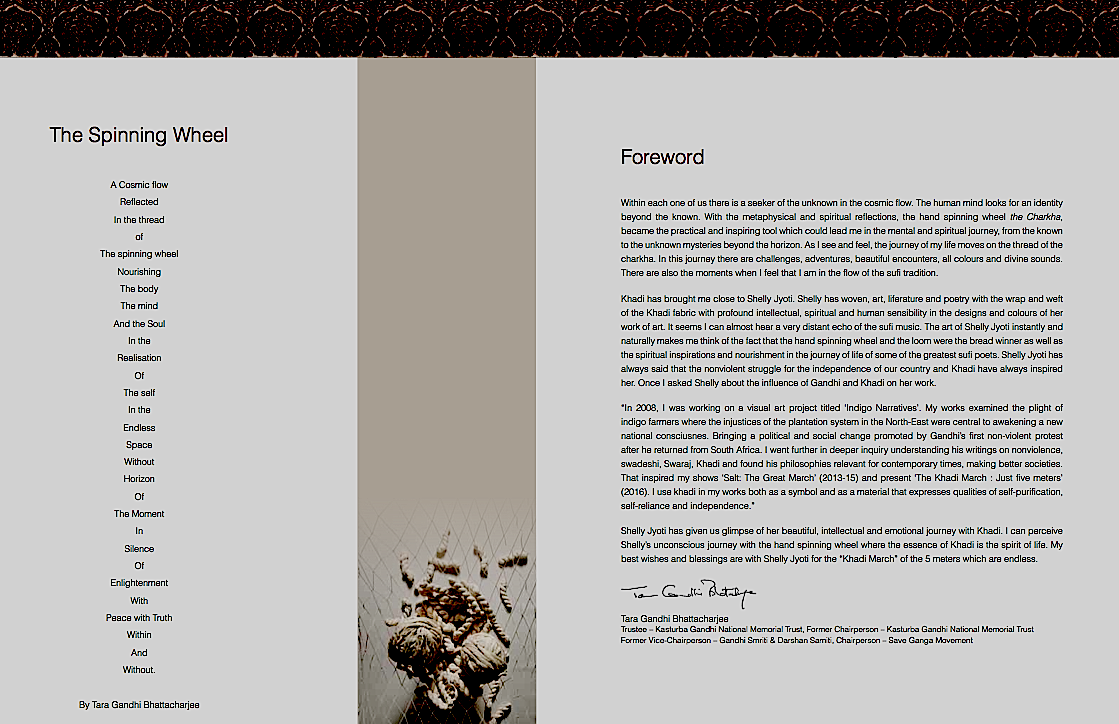

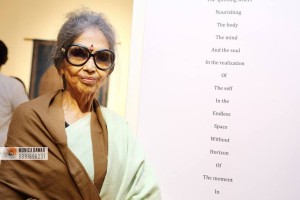
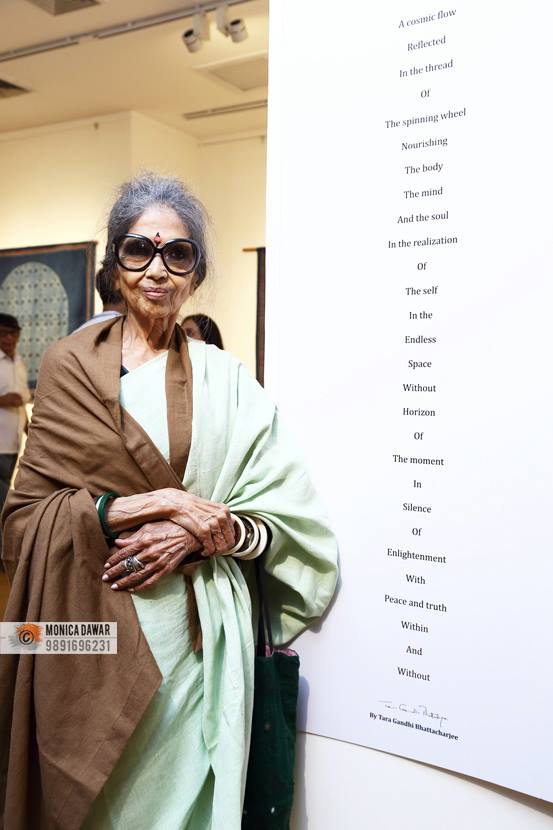

With Smt Tara Gandhi Bhattacharjee and her daughter Sukanya Bharatram and Shelly Jyoti
